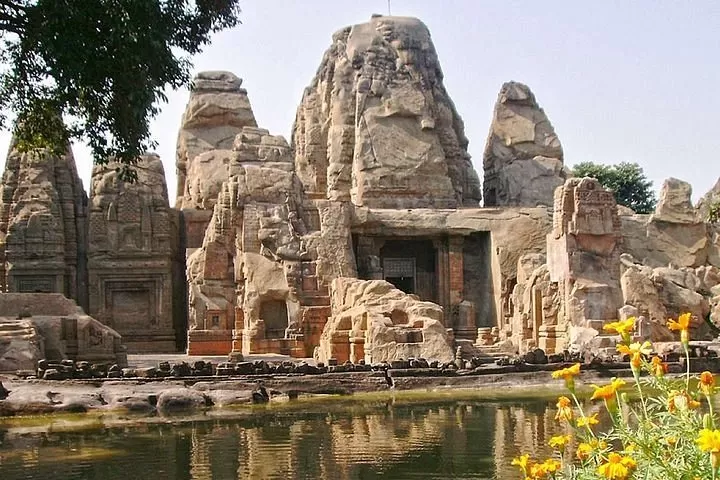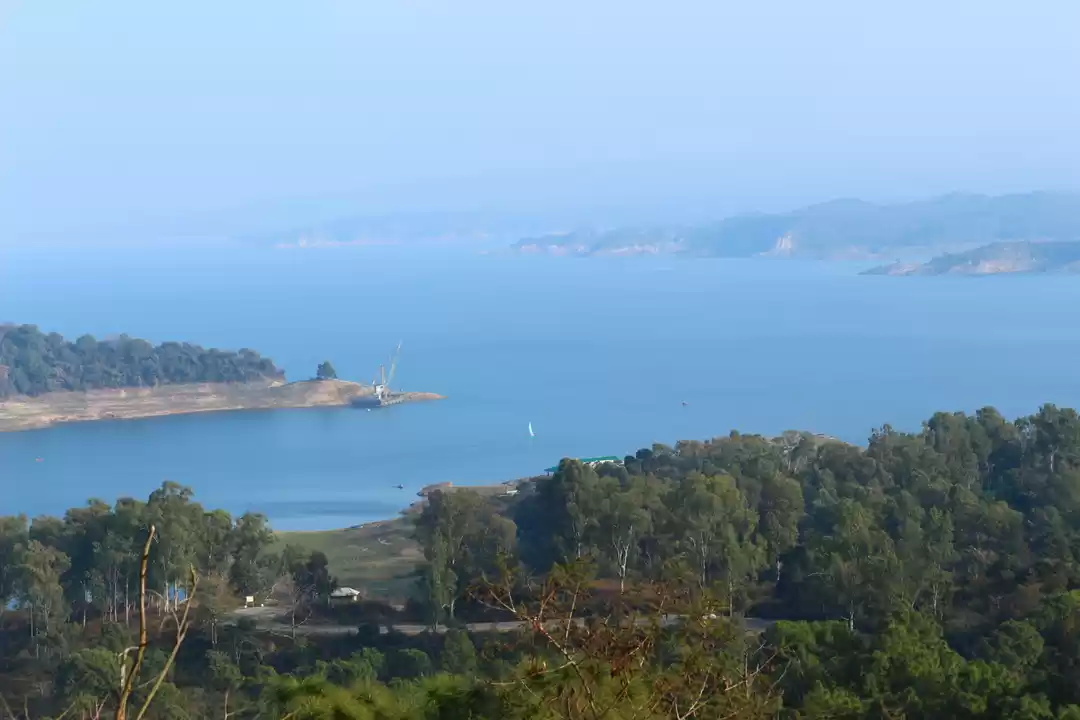Have you ever wondered what it would be like to visit a temple that is carved out of a single rock? A temple that has been standing for over a thousand years, with intricate carvings and sculptures that depict the ancient Hindu mythology? A temple that offers a breathtaking view of the snow-capped mountains and the serene reservoir? If you are looking for such a temple, then you should head to Masroor Rock Cut Temple, a hidden gem of Himachal Pradesh.
Masroor Rock Cut Temple is a stunning monolithic temple complex located in the Kangra district of Himachal Pradesh, about 40 km from Mcleodganj. It is also known as the Himalayan Ellora, as it resembles the famous Ellora Caves in Maharashtra. The temple complex consists of 15 rock-cut temples, dedicated to various Hindu deities, such as Shiva, Vishnu, and Devi. The temples are rich in history, legend, and architecture, and are considered to be one of the finest examples of rock-cut temples in India.
In this article, we will explore the beauty and mystery of Masroor Rock Cut Temple, and tell you everything you need to know before you plan your trip to this amazing destination. We will cover the history and legend of the temple, its architecture and design, its location and scenery, how to reach and visit the temple, and the best time and season to visit the temple. By the end of this article, you will be ready to pack your bags and head to this Himalayan Ellora.
History and Legend of Masroor Rock Cut Temple
The origin and meaning of the name Masroor is not clear, but some believe that it is derived from the Arabic word masrur, which means happy or delighted. The temple complex is also known as Masrur Temples or Masroor Temples.
The legend of the temple is linked to the epic Mahabharata, and the five Pandava brothers, who were the heroes of the story. According to the legend, the Pandavas built the temple during their exile, and hid their weapons inside one of the temples. The temple also has a secret passage that leads to the nearby hills, where the Pandavas used to escape from their enemies.
The historical evidence and sources that date the temple to the 8th century are scarce, but some scholars suggest that the temple was built by the Katoch Dynasty, who ruled the Kangra region from the ancient times. The temple was influenced by the Nagara style of architecture, which was prevalent in North India at that time. The temple also bears some resemblance to the Pratihara style of architecture, which was popular in Central India.
The temple complex was damaged by an earthquake in the 19th century, which caused some of the temples to collapse and some of the sculptures to break. The temple complex was also looted and vandalized by the invaders and the local people over the years. The temple complex is now under the protection of the Archaeological Survey of India, which has undertaken some restoration and conservation work.
Architecture and Design of Masroor Rock Cut Temple
The temple complex is a marvel of engineering and art, as it is carved out of a single rock. The rock is a sandstone formation, which is easy to cut and sculpt. The temple complex covers an area of about 4,000 square meters, and has a rectangular layout. The temple complex has three entrances, one on the east, one on the west, and one on the south.
The temple complex consists of 15 rock-cut temples, arranged in a symmetrical pattern. The temples are of different sizes and shapes, but they share some common features, such as a shikhara (spire), a mandapa (hall), and a garbhagriha (sanctum). The temples are dedicated to various Hindu deities, such as Shiva, Vishnu, and Devi. The main temple, which is located in the center of the complex, is dedicated to Shiva, and has a shivalinga (a symbol of Shiva) inside the garbhagriha. The main temple is also the largest and the tallest temple, with a height of about 15 meters.
The temples are adorned with intricate carvings and sculptures, depicting Hindu deities and scenes from the Hindu mythology. The carvings and sculptures are made in high relief, and show a high degree of skill and craftsmanship. The carvings and sculptures also reflect the influence of various artistic styles, such as Gupta, Pallava, and Chalukya. Some of the notable carvings and sculptures are:
The Dashavatara (the ten incarnations of Vishnu) panel, which is located on the north wall of the main temple. The panel shows the ten forms of Vishnu, such as Matsya (fish), Kurma (turtle), Varaha (boar), Narasimha (man-lion), Vamana (dwarf), Parashurama (warrior), Rama (prince), Krishna (cowherd), Buddha (sage), and Kalki (horseman).
The Durga (the goddess of power) panel, which is located on the south wall of the main temple. The panel shows Durga slaying the buffalo-demon Mahishasura, with the help of her lion mount and her weapons. The panel also shows the other gods and goddesses, such as Shiva, Brahma, Vishnu, Lakshmi, Saraswati, and Ganesha, witnessing the battle.
The Saptamatrika (the seven mother goddesses) panel, which is located on the east wall of the main temple. The panel shows the seven goddesses, who are the consorts of Shiva, such as Brahmani, Vaishnavi, Maheshvari, Indrani, Kaumari, Varahi, and Chamunda. The panel also shows a male figure, who is either Shiva or Skanda, the son of Shiva and Parvati.
The Ganga (the goddess of the river Ganges) panel, which is located on the west wall of the main temple. The panel shows Ganga descending from the heaven to the earth, with the help of Shiva, who holds her in his matted hair. The panel also shows the other gods and goddesses, such as Brahma, Vishnu, Lakshmi, Saraswati, and Indra, witnessing the event.
The temple complex is often compared to other famous sites, such as Angkor Wat in Cambodia and Ellora Caves in Maharashtra. The temple complex is similar to Angkor Wat in its layout, symmetry, and orientation, and to Ellora Caves in its rock-cut technique, style, and theme.
Location and Scenery of Masroor Rock Cut Temple
The temple complex is located in a scenic setting, surrounded by the Dhauladhar range and the Kangra Valley. The temple complex is situated on a hilltop, at an altitude of about 1,000 meters above sea level. The temple complex offers a panoramic view of the snow-capped mountains and the reservoir, which is formed by the Masroor Dam. The temple complex is also a part of the Great Himalayan National Park, which is a UNESCO World Heritage Site.
The temple complex is not only a cultural heritage site, but also a natural heritage site. The temple complex is home to various flora and fauna, such as pine trees, orchids, birds, and butterflies. The temple complex is also a place of spiritual and religious significance, as it is believed to be a shakti peetha (a place of power) and a jyotirlinga (a place of light). The temple complex attracts many pilgrims and devotees, especially during the festivals of Shivaratri and Navratri.
How to Reach and Visit Masroor Rock Cut Temple
The temple complex is about 40 km from Mcleodganj, which is a popular hill station and a tourist destination in Himachal Pradesh. Mcleodganj is also known as the Little Lhasa, as it is the residence of the Dalai Lama and the headquarters of the Tibetan government-in-exile. Mcleodganj is well-connected by road, rail, and air to other parts of India.

The best way to reach the temple complex from Mcleodganj is by road, as there are no direct trains or flights to the temple complex. You can hire a taxi or a bus from Mcleodganj to the temple complex, which will take about an hour and a half. You can also rent a bike or a car from Mcleodganj and drive to the temple complex, which will give you more flexibility and convenience. The road to the temple complex is narrow and winding, but it offers some spectacular views of the mountains and the valley.
The temple complex is open from 6 am to 6 pm, and the entrance fee is Rs. 25 per person. The temple complex has a parking lot, a ticket counter, a souvenir shop, and a cafeteria. The temple complex also has a guide service, which can provide you with more information and insights about the temple complex. The guide fee is Rs. 100 per hour. The temple complex does not have any accommodation.
Best Time and Season to Visit Masroor Rock Cut Temple
The climatic conditions and variations of the region are influenced by the altitude and the proximity to the Himalayas. The region experiences four seasons: summer, monsoon, winter, and spring. The temperature ranges from 5°C to 35°C, depending on the season and the time of the day.

The ideal season and month to visit the temple complex is spring, which lasts from March to May. The spring season offers a pleasant and comfortable weather, with clear skies and moderate temperatures. The spring season also brings out the beauty and freshness of the flora and fauna, with colorful flowers and greenery. The spring season is also the best time to witness the festivals of Shivaratri and Navratri, which are celebrated with great fervor and devotion at the temple complex.

The summer season, which lasts from June to August, is also a good time to visit the temple complex, as it offers a respite from the heat and humidity of the plains. The summer season has a warm and sunny weather, with occasional showers and thunderstorms. The summer season is also a good time to enjoy some adventure activities, such as trekking, camping, and paragliding, in the nearby areas.
The monsoon season, which lasts from September to November, is the least favorable time to visit the temple complex, as it brings heavy rainfall and landslides, which can disrupt the road and the temple complex. The monsoon season also reduces the visibility and the scenic beauty of the temple complex, as the mountains and the reservoir are covered by clouds and mist. The monsoon season also poses some challenges and risks for the visitors, such as slippery paths, waterlogging, and leeches.
The winter season, which lasts from December to February, is also a challenging time to visit the temple complex, as it brings cold and harsh weather, with snowfall and frost. The winter season lowers the temperature and the accessibility of the temple complex, as the roads and the temple complex are often blocked by snow and ice. The winter season also requires some extra preparation and precaution for the visitors, such as warm clothes, woolen socks, gloves, and caps.
Masroor Rock Cut Temple is a hidden gem of Himachal Pradesh, that deserves to be explored and admired by every traveler. The temple complex is a masterpiece of engineering and art, that showcases the ancient Hindu culture and mythology. The temple complex is also a place of natural and spiritual beauty, that offers a spectacular view of the Himalayas and the reservoir. The temple complex is a perfect destination for anyone who loves history, architecture, religion, or nature.
If you are planning to visit Masroor Rock Cut Temple, we hope that this article has provided you with all the information and insights that you need. We also hope that this article has inspired you to discover and experience this Himalayan Ellora for yourself. So, what are you waiting for? Book your tickets and pack your bags, and get ready for an unforgettable trip to Masroor Rock Cut Temple.
We would love to hear from you about your trip and your feedback on this article. Please share your comments and suggestions below, and let us know how we can improve our content and service. Thank you for reading and happy traveling!



















